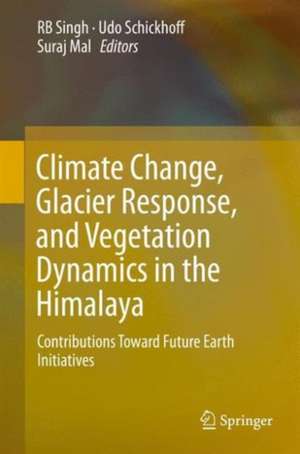Climate Change, Glacier Response, and Vegetation Dynamics in the Himalaya: Contributions Toward Future Earth Initiatives
Editat de Rb Singh, Udo Schickhoff, Suraj Malen Limba Engleză Hardback – 16 iun 2016
The book covers relevant aspects of accelerated climate change observed in the Himalayan mountain system, and highlights the regional differentiation of climatic changes and associated environmental modifications. The focus is on climate variability and change, and how physical systems and ecosystems respond to climate change impacts. Consequences include impacts on physicalsystems such as glacier shrinkage, glacial lake outburst floods, altered hydrological characteristics, permafrost warming and thawing, and mass movements on slopes. Climate change is also a powerful stressor on ecosystems and induces range shifts of plant and animal species and alterations in terms of phenology, biomass, plant cover, plant group dominance and species composition. Thus, ecosystem structure and functioning will be strongly affected.The book has an introductory chapter followed by a section on climate change, a section on impacts on glaciers and hydrology, and a section on vegetation dynamics. Each section has several chapters presenting key concepts, major drivers and key processes of environmental change in the Himalayan region from different perspectives. Climate change impacts in the Himalaya have not been studied in much detail, and respective findings were not presented so far in a comprehensive overview. This book summarizes the current knowledge of interactions between climate change and the dynamics of glaciers, hydrology, and vegetation.
| Toate formatele și edițiile | Preț | Express |
|---|---|---|
| Paperback (1) | 569.60 lei 38-44 zile | |
| Springer International Publishing – 30 mai 2018 | 569.60 lei 38-44 zile | |
| Hardback (1) | 595.47 lei 38-44 zile | |
| Springer International Publishing – 16 iun 2016 | 595.47 lei 38-44 zile |
Preț: 595.47 lei
Preț vechi: 744.33 lei
-20% Nou
Puncte Express: 893
Preț estimativ în valută:
113.94€ • 119.28$ • 94.28£
113.94€ • 119.28$ • 94.28£
Carte tipărită la comandă
Livrare economică 01-07 aprilie
Preluare comenzi: 021 569.72.76
Specificații
ISBN-13: 9783319289755
ISBN-10: 3319289756
Pagini: 350
Ilustrații: XVI, 399 p. 152 illus., 105 illus. in color.
Dimensiuni: 155 x 235 x 28 mm
Greutate: 0.98 kg
Ediția:1st ed. 2016
Editura: Springer International Publishing
Colecția Springer
Locul publicării:Cham, Switzerland
ISBN-10: 3319289756
Pagini: 350
Ilustrații: XVI, 399 p. 152 illus., 105 illus. in color.
Dimensiuni: 155 x 235 x 28 mm
Greutate: 0.98 kg
Ediția:1st ed. 2016
Editura: Springer International Publishing
Colecția Springer
Locul publicării:Cham, Switzerland
Public țintă
ResearchCuprins
Climate Change and Dynamics of Glaciers and Vegetation in the Himalaya: An Overview.- Section I: Climate Change.- Recent Climate Change over High Asia.- Analytic Comparison of Temperature Lapse Rates and Precipitation Gradients in a Himalayan Treeline Environment – Implications for Statistical Downscaling.- Climate Change and Hydrological Responses in Himalayan Basins, Nepal.- Spatial and Temporal Variability of Climate Change in High-Altitude Regions of NW Himalaya .- Assessing Climatic Change Signals in Western Himalayan District using PRESIS model.- Climate Change in Pindari Region, Central Himalaya, India.- Section II: Climate Change Impacts on Glaciers and Hydrology.- Glacier Variations in the Trans-Alai Massif and the Lake Karakul Catchment (Eastern Pamir) Measured from Space.- Heterogeneity in Fluctuations of Glacier with Ice-cover, Debris-Cover and Proglacial-lake in the Upper Ravi Basin, Himachal Himalaya (India)During the Past Four Decades (1971-2013).- Current and Future Glacial Lake Outburst Flood Hazard: Application of GIS Based Modeling in Himachal Pradesh, India.- Estimating Recent Glacier Changes in Central Himalaya, India, Using Remote Sensing Data.-Instability Processes Triggered by Heavy Rain in the Garhwal Region, Uttarakhand, India.- The Need for Community Involvement in Glacial lake Field Research: The Case of Imja Glacial Lake, Khumbu, Nepal Himalaya.- Understanding Factors Influencing Hydro-Climatic Risk and Human Vulnerability: Application of Systems Thinking in the Himalayan Region.- Section III: Climate Change and Vegetation Dynamics.-Climate Change and Treeline Dynamics in the Himalaya.- Treeline Responsiveness to Climate Warming: Insights From a Krummholz Treeline in Rolwaling Himal, Nepal .- Dendroecological Perspectives on Climate Change on the Southern Tibetan Plateau.- Spatially Variable Vegetation Greenness Trends in Uttarakhand Himalayas in Response to Environmental Drivers.- Impact of Glacier Recession on the Vegetational Cover of Valley of Flowers National Park (a world heritage site), Central Himalaya, India.-Snow Cover Dynamics and Timberline Changes Detection of Yamunotri Watershed using Multi Temporal Satellite Imagery.
Recenzii
“The collection of chapters represents an in-depth analysis of trends in temperature and precipitation in different areas of the region. … The editors of this volume have created an excellent work that integrates climate change in the Himalayas with numerous ecological dynamics. Summing Up: Recommended. Graduate students, researchers, professionals.” (J. L. Hatfield, Choice, Vol. 54 (5), January, 2017)
"The focus on elevation and the diversity of topics presented within this book represent its greatest strengths. … the book provides both breadth and detail on ongoing environmental changes in the Himalayas. … it would be suitable for researchers and graduate-level students working in the region on a variety of topics, or as a reference book for upper-level courses on mountains and environmental change." (Joseph Shea, Mountain Research and Development, Vol. 37 (3), August, 2017)
Textul de pe ultima copertă
This book provides information essential for anyone interested in climate and environmental change of the Himalayan region, including land and resource managers, environmental planners, conservationists, environmentalists, geographers, climatologists, ecologists, and students. The book is unique in its coverage of the current understanding of the science of climate change in the Himalayan mountain system and of the major impacts on physical systems and ecosystems. The book gives an overview of the physical science basis of climate change and explains drivers and processes of glacier and vegetation dynamics.
The book covers relevant aspects of accelerated climate change observed in the Himalayan mountain system, and highlights the regional differentiation of climatic changes and associated environmental modifications. The focus is on climate variability and change, and how physical systems and ecosystems respond to climate change impacts. Consequences include impacts on physicalsystems such as glacier shrinkage, glacial lake outburst floods, altered hydrological characteristics, permafrost warming and thawing, and mass movements on slopes. Climate change is also a powerful stressor on ecosystems and induces range shifts of plant and animal species and alterations in terms of phenology, biomass, plant cover, plant group dominance and species composition. Thus, ecosystem structure and functioning will be strongly affected.The book has an introductory chapter followed by a section on climate change, a section on impacts on glaciers and hydrology, and a section on vegetation dynamics. Each section has several chapters presenting key concepts, major drivers and key processes of environmental change in the Himalayan region from different perspectives. Climate change impacts in the Himalaya have not been studied in much detail, and respective findings were not presented so far in a comprehensive overview. This book summarizes the current knowledge of interactions between climate change and the dynamics of glaciers, hydrology, and vegetation.
The book covers relevant aspects of accelerated climate change observed in the Himalayan mountain system, and highlights the regional differentiation of climatic changes and associated environmental modifications. The focus is on climate variability and change, and how physical systems and ecosystems respond to climate change impacts. Consequences include impacts on physicalsystems such as glacier shrinkage, glacial lake outburst floods, altered hydrological characteristics, permafrost warming and thawing, and mass movements on slopes. Climate change is also a powerful stressor on ecosystems and induces range shifts of plant and animal species and alterations in terms of phenology, biomass, plant cover, plant group dominance and species composition. Thus, ecosystem structure and functioning will be strongly affected.The book has an introductory chapter followed by a section on climate change, a section on impacts on glaciers and hydrology, and a section on vegetation dynamics. Each section has several chapters presenting key concepts, major drivers and key processes of environmental change in the Himalayan region from different perspectives. Climate change impacts in the Himalaya have not been studied in much detail, and respective findings were not presented so far in a comprehensive overview. This book summarizes the current knowledge of interactions between climate change and the dynamics of glaciers, hydrology, and vegetation.
Caracteristici
Trans-disciplinary book on the Himalaya Summarizes current knowledge of interactions between climate change and the dynamics of glaciers, hydrology, and vegetation The book is co-edited by the vice president of the International Geographical Union (IGU)




